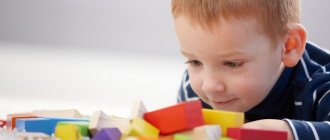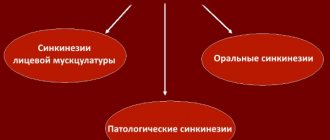Peculiarities of perception in speech disorders material on speech therapy on the topic
Peculiarities of perception in speech disorders
Violations of phonemic perception are noted in all children with speech disorders, and there is an undoubted connection between disorders of the speech-auditory and speech-motor analyzers. It is known that dysfunction of the speech motor analyzer in dysarthria and rhinolalia affects the auditory perception of phonemes (G.F. Sergeeva, 1973). At the same time, there is not always a direct relationship between disturbances in the pronunciation of sounds and their perception.
Children with speech disorders have specific difficulties in distinguishing subtle differentiated features of phonemes, which affect the entire course of development of the sound side of speech. They can have a secondary influence on the formation of sound pronunciation.
Such defects in children's speech, such as the use of diffuse sounds of unstable articulation, distortion of sounds correctly pronounced outside speech in an isolated position, numerous substitutions and confusions with a relatively formed structure and function of the articulatory apparatus, indicate a primary immaturity of phonemic perception.
Sometimes such children demonstrate auditory discrimination of those phonemes that are not contrasted in pronunciation, while in other cases, those phonemes that are differentiated in pronunciation are not distinguished either. Nevertheless, there is a certain proportionality here: the greater the number of sounds differentiated in pronunciation, the more successfully the phonemes are distinguished by ear. And the fewer “supports” there are in pronunciation, the worse the conditions for the formation of phonemic images. The development of phonemic hearing itself is in direct connection with the development of all aspects of speech, which, in turn, is determined by the general development of the child.
The study of visual perception allows us to draw conclusions that in preschool children with speech pathology this mental function lags behind the norm and is characterized by insufficient formation of a holistic image of an object (E.M. Mastyukova). Research shows that simple visual recognition of real objects and their images does not differ from the norm in these children.
Difficulties appear when tasks become more complex (recognition of objects in conditions of overlap, noise). Thus, children with ODD perceive the image of an object in complicated conditions with certain difficulties: the time of decision-making increases, children are not confident in the correctness of their answers, identification errors are noted, the number of which increases with a decrease in the number of informative features of objects.
In implementing the task of perceptual action (trying on a standard), children in this category more often use elementary forms of orientation, i.e. by trying on a standard, in contrast to children with normal speech, visual correlation is predominantly used. Children with ODD often, when trying on figures, are guided not by their shape, but by color. Moreover, boys often have lower results than girls.
When studying visual perception in children of primary school age with mental retardation, dysarthria and speech disorders of the alalia type, the following gnostic functions were studied: optical-spatial gnosis, spatial representations, facial gnosis, finger and oral stereognosis (the ability to perceive, recognize objects in a tactile-motor way, to the touch) (L.S. Tsvetkova, T.M. Pirtskhalaishvili, 1975).
Violations of optical-spatial gnosis are considered characteristic of children with organic brain damage. As a result of its study using L. Bender’s methodology, as well as during observations of the activities of children with speech pathology in the process of drawing, designing and learning to read and write, it was revealed that this function in children of primary school age, in comparison with normally developing peers, is at a much lower level.
The dynamics of development of spatial perception are most favorable in children with mental retardation, and least favorable in children with alalia. The degree of violation of optical-spatial gnosis also depends on the insufficiency of other processes of perception, especially the formation of spatial representations.
The perception of space is currently considered as the result of the joint activity of various analyzers.
In this case, important importance is given to the normal functioning of the parietal parts of the brain. The most distinct spatial impairments are observed in students of preparatory and first grades of speech schools.
Spatial disturbances are especially persistent in human drawing: the image is characterized by poverty, primitiveness and a small number of details, as well as the presence of specific optical-spatial disturbances (in children with alalia). However, spatial impairments in children with speech disorders are characterized by a certain dynamism and a tendency towards compensation.
A significant role of spatial disorders is seen in the severity and persistence of written language disorders (dyslexia and dysgraphia), and counting disorders that can be observed with speech disorders. Studies of the ability to establish spatial relationships between phenomena of reality in objective-practical activities and understand them in impressive speech indicate the preservation of these abilities. But in expressive speech, children with severe speech pathology often do not find linguistic means to express these relationships or use incorrect linguistic means. This is due to a disruption in their processes of recoding a preserved semantic program into a linguistic form.
Studies of facial gnosis (using the Tardieu technique) show a relationship between its impairments (especially in the area of oral muscles) and the severity of sound pronunciation disorders. Thus, the most pronounced violations of facial gnosis are characteristic of children with dysarthria and alalia.
Impairments of oral and digital stereognosis were studied using general methods described in the domestic literature, as well as using the method of R.L. Ringel, when the child was asked to determine the shape of objects placed in his mouth. The most pronounced disturbances were observed in children with the most severe deficiencies in expressive speech (especially in children with alalia and dysarthria, when their phonetic aspects of speech were severely impaired).
Significant impairments in oral stereognosis are also observed in children with severe impairments in facial gnosis. No impairments of finger stereognosis were identified in children with speech disorders.
Other studies also indicate a lag in the development of visual perception and object-based visual images in children with various forms of dysarthria and mental retardation in the absence of primary intellectual impairment. It has been revealed that visual impairments in children with severe speech pathology manifest themselves mainly in poverty and undifferentiation of visual images, inertia and fragility of visual traces, as well as in the absence of a strong and adequate connection between the word and the visual representation of the object. Preschool children with speech pathology are more likely to be impaired in visual perception and object-based visual images and, to a lesser extent, in visual operative memory, which is grossly impaired in children with intellectual disabilities, although this group of children suffers less from visual perception.
These provisions indicate that the sensory development of a child with speech impairments is significantly behind in terms of development and is extremely uneven.
Diagnosis of perception disorders
When diagnosing perception disorders, we can distinguish several levels of development of speech understanding in children with ODD.
1. Zero: a child with intact hearing does not perceive the speech of others, sometimes reacts to his name, less often to intonations of prohibition or encouragement.
2. Situational: the child understands requests related to the everyday objective world, knows the names of loved ones and the names of his toys, can show parts of the body in himself, in his parents, in a doll, but does not distinguish, based on a verbal request, images of objects, toys that are well known to him in his life. everyday life
3. Nominative: the child is well versed in the names of objects depicted in individual pictures, but has difficulty understanding the names of actions depicted in plot pictures (walking, sitting, reading). He does not understand questions of indirect cases at all (with what? to whom? with whom?).
4. Predicative: the child knows many names of actions, easily navigates questions of indirect cases posed to objects of actions depicted in plot pictures, distinguishes the meanings of several primitive prepositions (put on the box, in the box, near the box). Does not distinguish between grammatical forms of words.
5. Dissected: the child distinguishes changes in meanings introduced by individual parts of the word (morphs) - inflections, prefixes, suffixes (“table - tables”, “flew away - flew in”).
Before examining speech perception, it is necessary to familiarize yourself with the results of a child’s physical hearing test. It has been established that even a slight decrease in hearing acuity in early childhood leads to the inability to distinguish speech sounds and pronounce them clearly. The presence of normal hearing acuity is an important condition for the formation of phonemic perception.
It is also necessary to observe how the child controls his pronunciation and how much he is able to distinguish whether the word form presented to him is correct. With underdevelopment of phonemic perception, children whose pronunciation contains sound substitutions do not notice pronunciation deficiencies in other people’s speech. To diagnose the characteristics of perception in children with speech impairments, a set of techniques is used.
Types of speech disorders in children
Major speech disorders:
- Alalia is a complete absence or severe underdevelopment of speech. It occurs due to damage to the speech centers of the brain, which occurred in utero or in the first 3 years of a child’s life. In case of underdevelopment of speech, there is a late onset of conversation, poor vocabulary, difficulties in constructing sentences, and a violation of phonemic processes.
- Rhinolalia is a disorder of voice formation and articulation, which is caused by pathology of the structure and functioning of the speech apparatus. Symptoms include: problems with vocabulary and speech grammar, distortions in sound pronunciation, problems with written speech, and disruption of phonemic processes.
- Aphasia is a pathology of the formation, reproduction or perception of speech. The child loses the ability to understand other people's speech or use his own. At the same time, the hearing organs and muscles of the articulatory apparatus are intact. The disorder occurs due to organic damage to the centers of perception or speech formation.
- Dysarthria is a disorder in the pronunciation of individual words, sounds or syllables. Caused by pathology of the muscles involved in the act of speech and the central part of the speech motor analyzer. Dysarthria includes problems with sound pronunciation, speech breathing, and speech motor skills.
- Stuttering is a spasm of the laryngeal and articulatory muscles, due to which the child lingers on any sound and often repeats sounds, syllables, and words. Speech can completely stop at the moment of stuttering or break the smoothness of the conversation and its rhythm.
Where to go if your child has speech problems?
Speech disorders require long-term, targeted correction work under the guidance of a speech therapist. It is important to find a qualified specialist who has a wide range of knowledge and techniques for treating speech therapy disorders. With a responsible attitude towards the development of a child’s speech, it is possible to completely adapt him to interaction with society, communication, and learning at school.
Our clinic welcomes a professional speech pathologist with many years of experience, an honorary member of the National Association of Speech Therapists. We will be happy to help your children overcome any difficulties with speech and enjoy full and joyful communication with the outside world.


